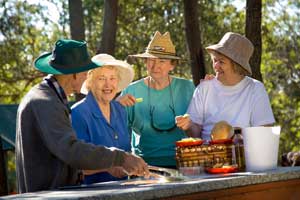Stay on your Feet® - Extra E's of injury
Over time, the original, three E's of injury prevention have been expanded to include the following:
Evaluation
Evaluation provides valuable information regarding the appropriateness, adequacy and effectiveness of falls prevention projects/programs or materials and, if necessary, how they can be improved.
Evaluation is an important component of project management that is best considered during the entire span of the project/program and after completion [23].
During evaluation, there are two types of information that can be collected:
-
qualitative - subjective information
-
quantitative - numerical and objective information.
The Four Phases of Evaluation
-
Formative evaluation also known as pilot testing, pre-testing or focus testing, for example: testing a television commercial in story-board (comic strip) format with the target group before filming.
-
Process evaluation measures the activities of the project/program, the quality of the project/program and who is being reached, for example: how many education sessions were conducted, attendance rates and the satisfaction of attendees.
-
Impact evaluation measures the immediate or short-term effect of the project/program. This often relates to the project/program objectives, for example: how the project/program has changed the target group's behaviour, attitudes, skills etc.
-
Outcome evaluation measures the long-term effects of the project/program. This often relates to the project/program goal, for example: how a project/program has reduced falls in older people.
For more information, refer to the Stay On Your Feet® Community Good Practice Toolkit: Phase 4 - Review.
Evidence
Evidence is based on scientific research regarding what actions have been successful in reducing injury. To find out what works, it is best to look at the scientific research about what has been effective in reducing falls in older people. The following types of research provide higher levels of evidence. These include systematic reviews, meta analyses and randomised control trials.
Engagement
As no one agency or department can address falls prevention alone, it is important to engage individuals, communities, health professionals, policy makers and business in falls prevention projects/programs. This process is known as community engagement.
There is a need to form and maintain collaborative partnerships with those who have existing or potential passive and active roles to play in falls prevention and healthy active ageing.
Ongoing and active engagement is based on the identifying mutual benefits and common goals in a setting of trust and respect, which in turn fosters sharing of responsibility and resources.
Epidemiology
The term epidemiology is based on a Greek word meaning 'the study of people' [65]. Epidemiology provides information essential for the management, evaluation and planning of services for the prevention, control and treatment of falls and helps to identify the underlying factors for injury and falls [65]. These include:
Exsiting falls data can provide important information for planning falls prevention projects/programs and monitoring their effectiveness.
Economic
The economic impact of falls takes into account the following:
-
the value of life, which can be measured by quality, adjusted life years (QALYs)
-
the loss of normal function due to reduced mobility or disability
-
indirect (or lifetime) costs, including the impact on the faller and carer, for example: loss of both paid and unpaid work productivity
-
direct health care cost, which relates to the cost of treating a fall including ambulance, specialists, hospital treatment, medication and rehabilitation.
Falls prevention has the potential to benefit society. As prevention interventions aim to avoid the most costly types of falls-related care, such as hospital treatment and rehabilitation, thus falls prevention has the potential to be very cost effective [23].
To ensure project/program interventions are cost effective, and to assist with identifying which intervention/s offer the best value for money, the economic impact of falls prevention interventions is an important component of evaluation [20].
There is increasing recognition that many modern health problems, such as falls, result from the complex interaction of social, economic, environmental, behavioural and genetic determinants over the course of a person's life. For example: poor nutrition can lead to reduced bone strength, which increases the risk of a fall-related fracture in older people.
It is still important to address the social determinants of health as an important component of falls prevention.
Economic incentives can lead to the reduction of injuries, for example: providing free bathroom modifications, such as grab rails, in older people's homes and working with manufacturers to improve safety devices without increasing their costs.

Other E's
Achieving success in projects/programs requires Enthusiasm and Empowerment of the target group. These two factors have also been suggested as additional E's worthy of consideration.
There may be more E's you feel, from your own Experience, are an important part of falls prevention in older people.